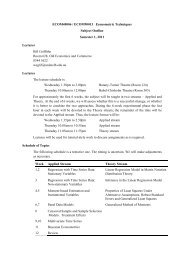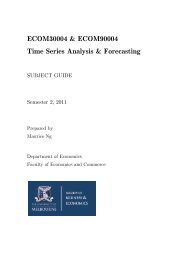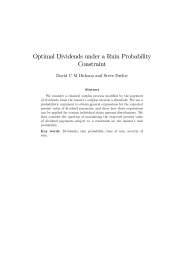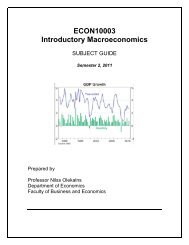A Model of Optimal Corporate Bailouts - Faculty of Business and ...
A Model of Optimal Corporate Bailouts - Faculty of Business and ...
A Model of Optimal Corporate Bailouts - Faculty of Business and ...
Create successful ePaper yourself
Turn your PDF publications into a flip-book with our unique Google optimized e-Paper software.
Yet another difference <strong>of</strong> our model from ? is that inefficient investment in our model doesnot arise because <strong>of</strong> a debt overhang problem. In fact, we do not view our model as much amodel <strong>of</strong> banks, as we view it <strong>of</strong> a model <strong>of</strong> government bailouts for generic non-bank firms,such as the GM <strong>and</strong> Chrysler. But like ?, we focus on the socially inefficient aspects <strong>of</strong> firmbehavior. <strong>Bailouts</strong> are needed because it is too costly for the firm to finance continuation, giventheir struggle with their own internal moral-hazard (managerial agency) problems. Our paperfocused on on the internal <strong>and</strong> external moral-hazard problems <strong>and</strong> their best remedies. Ourdistortive tax effects are endogenous, <strong>and</strong> not linear as in ?. We also <strong>of</strong>fered specific policyrecommendations (on managerial <strong>and</strong> owner retention, bailout funding, etc.) different fromthose in ?, <strong>and</strong> showed that firms <strong>and</strong> managers—the Chamber <strong>of</strong> Commerce—will lobby for asystem in which they do not face a priori taxation to cover future bailouts.? <strong>and</strong> ? study adverse-selection models, in which firms differ in the publicly-unknownqualities <strong>of</strong> their existing assets. In contrast, our model studies moral-hazard problems in firmswith known assets <strong>and</strong> opportunities. In their models, the government ends up subsidizing onlythe worst types, whereas in our model, the government ends up subsidizing only the marginaltypes. In their models, the parameterized cost <strong>of</strong> public funds is exogenous, whereas in ourmodel, the costs <strong>of</strong> raising bailout revenue (through taxes) is endogenous. This is important,because distortionary taxes (<strong>and</strong> T 2 , in particular) reduce managerial effort <strong>and</strong> are thus directlyresponsible for our policy prescriptions. In ?, the acceptance <strong>of</strong> government assistance sends anegative signal to outside capital market participants, which increases the recipients’ privateborrowing costs outside <strong>of</strong> the program. ? government objective is to obtain a target level<strong>of</strong> investment that is the cheapest to taxpayers. In our model, the government maximizestotal social value instead. Their optimal government intervention is a debt contract. Our’s isa direct subsidy (because any government stake raises the required subsidy to entice privateparticipants). In ?, there is a spillover aspect <strong>of</strong> bailouts. The bailout <strong>of</strong> one firm raises the cost<strong>of</strong> the next bailout. Firms become progressively more hesitant to participate as progressivelyweaker banks have already been bailed out before them. Like ?, the government takes stakes inexchange for its subsidy, though in equity <strong>and</strong> direct purchases <strong>of</strong> firm assets, whereas in ourmodel, the government should take no such stake. 24There are also pre-2008 crisis papers in the banking literature in which bailouts can bevaluable. For example, in ?, banks would lose socially valuable information if allowed todisappear. In ?, asset prices depend on liquidity, <strong>and</strong> the government can enhance assetvalues by tapping its effectively unlimited credit. In ?, managers can be reluctant to liquidateunderperforming loans when bank regulators close bankrupt banks aggressively. <strong>Bailouts</strong> aredesigned to minimize such welfare losses. The classic paper advocating some governmentinvolvement is ?, which showed how the private market can fail <strong>and</strong> how deposit insuranceor convertibility restrictions can enhance the social outcome. As expected, deposit insurance24 Like us, Tirole suggests “just enough” intervention. Although moral hazard is not central to his analysis, hedemonstrates (as do we) that bailouts can exacerbate moral-hazard concerns. The paper does not derive anoptimal bailout in the presence <strong>of</strong> moral hazard.28
















